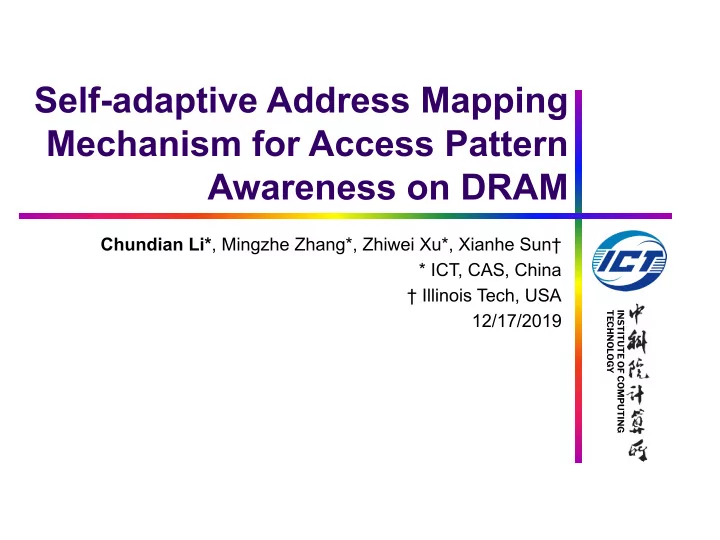

Self-adaptive Address Mapping Mechanism for Access Pattern Awareness on DRAM Chundian Li* , Mingzhe Zhang*, Zhiwei Xu*, Xianhe Sun† * ICT, CAS, China † Illinois Tech, USA TECHNOLOGY INSTITUTE OF COMPUTING 12/17/2019
Outline INSTITUTE OF COMPUTING TECHNOLOGY ● Introduction & Background ● Motivation ● Design ● Experiments ● Conclusion ● Future work
Introduction INSTITUTE OF COMPUTING TECHNOLOGY ● Memory wall. ● DRAM serve data accesses in two efficient ways. Locality: row buffer. ● Memory-level parallelism (MLP): channel/bank parallelism. ● ● Worst case. Neither locality nor concurrency. ● When and Why? ● ● Mismatch between data layout and access pattern. Data layout: row-major, column-major, bank-major, etc. ● Access pattern: stream, stride, random, pointer, etc. ● (Take regular access patterns in our study). ●
Background INSTITUTE OF COMPUTING TECHNOLOGY ● Layout <- Address Mappings RI: spatial row-buffer locality. ● XOR: increase MLP potential. ● CI: bank parallelism. ● ● How about these mappings? Row bits are in the high zone. ● Designed for accesses with short distance. ● ● Problems? If distance is quite long, how? ● Worst case will appear. ● Take Matrix Multiplication as an example. ● XOR can really match all the access patterns? ● No. ●
Motivation INSTITUTE OF COMPUTING TECHNOLOGY ● Take three versions and scales of GEMM as cases. ● Naïve. ● Cache-friendly: tiling. ● Highly-optimized: Intel MKI. ● Metrics. ● IPC for whole execution. ● DRAM performance: APC. ● Locality: row-buffer miss rate. ● Concurrency: MLP.
Motivation INSTITUTE OF COMPUTING TECHNOLOGY ● Observation 1. ● RI/ XOR/ CI may fail to provide its advantages when they happen to mismatch access pattern on DRAM.
Motivation INSTITUTE OF COMPUTING TECHNOLOGY ● Observation 2. ● Performance of XOR conquers one of CI, or the other way around on different patterns.
Motivation INSTITUTE OF COMPUTING TECHNOLOGY ● Bit flip: ● address distance. ● Observation 3. ● RI/ XOR/ CI may all degrade DRAM performance when bit flips are outstanding. ● Consecutive accesses span a long distance that disables both locality and MLP.
Design INSTITUTE OF COMPUTING TECHNOLOGY ● Two tags. Distinguish two procedures. ● MC decides when to sample. ● ● Software-level: Ctrl Loader. Interact with MC. ● ● Hardware-level: MC Modifications. Flip sampling. ● Pattern-aware Prediction. ●
Design INSTITUTE OF COMPUTING TECHNOLOGY ● Flip sampling. Care about adjacent accesses. ● Light-weight. ● Little cost. ● ● Access pattern. Check bit flips for all 64 bits. ● Decide which bit is outstanding. ● Reduce side effects of access thrashing. ●
Design INSTITUTE OF COMPUTING TECHNOLOGY ● Pattern-aware Prediction. ● Basic idea: Reshape the layout to match the access pattern. ● ● Based on prominent flipping. ● Two strategies. (Aggressiveness control) Locality-based strategy. ● MLP-based strategy. ● ● Profit model for this mechanism.
Experiments INSTITUTE OF COMPUTING TECHNOLOGY ● Testbed. Ramulator + Champsim. ● Representative benchmarks: diverse scales of GEMM. ● Baseline: XOR. ●
Experiments INSTITUTE OF COMPUTING TECHNOLOGY ● DRAM performance. MLP-based strategy. ● Naïve: 2.1x. ● Tiling: 1.4x. ● Locality-based. ● Naïve: 1.9x. ● Tiling: 1.7x. ● Intel MLK: 1.6x. ●
Experiments INSTITUTE OF COMPUTING TECHNOLOGY ● IPC for whole execution. Execution time decreases by 24%, 8%, and 7% averagely. ●
Experiments INSTITUTE OF COMPUTING TECHNOLOGY ● Sensitivity study. [1]-λ. How much frequency of bit flips is prominent to the access ● pattern [2]-σ. Speed of reaction. ●
Conclusion INSTITUTE OF COMPUTING TECHNOLOGY ● Key observation. ● Inefficiency comes from the mismatch of access patterns and data layout. ● Worst case: both locality and parallelism are harmed. ● An adaptive address mapping mechanism to be aware of access patterns. ● Bridging the huge mismatch between access patterns and data layout on DRAM. ● Adjustable to different access patterns by adopting suitable mappings to gain either locality or bank parallelism.
Future work INSTITUTE OF COMPUTING TECHNOLOGY ● Show potential on other benchmarks. ● Dig more profit from other applications with regular patterns. ● Fast reshaping. ● Exploit efficient data movement in 3D-stack DRAM to support fast reshaping on runtime after predicting a suitable mapping.
INSTITUTE OF COMPUTING TECHNOLOGY Thank you. Q & A.
Recommend
More recommend